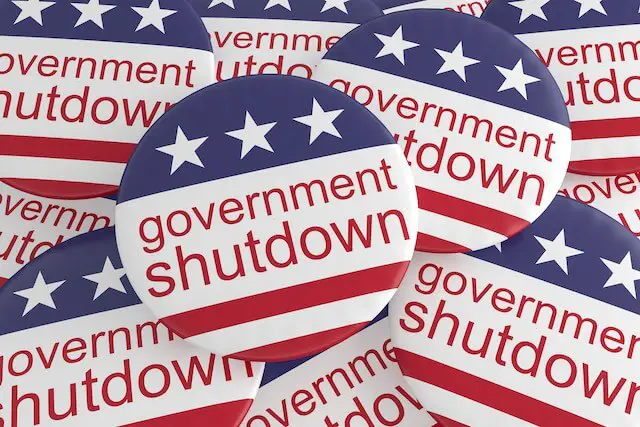As the government partial shutdown continues, the truth is that many Americans are feeling few of its effects.
In part this is because a number of government agencies are not affected by the shutdown, so their activities continue as normal.
Even in those agencies affected, the high number of Federal employees designated as “essential” in those agencies keeps many of the most visible parts of the government operating during the shutdown.
An example: The effect on government statistics
An area that is visible to much of the public are the vast statistical numbers produced each month by Federal agencies. These numbers are important to the Federal Reserve and are watched by many people both on Wall Street and Main Street, but even here the current shutdown has had minimal effect in the short run.
One example was Friday’s Employment Situation report. The important monthly numbers on employment and unemployment came out on time because the U.S. Bureau of Labor Statistics, which produces the numbers, is part of the Department of Labor, which has already had its appropriations passed by Congress and so is not affected by the shutdown.
In contrast, the Bureau of Economic Analysis, which produces a number of economic reports including the quarterly Gross Domestic Product (GDP) report, is part of the Department of Commerce and is affected.
On BEA’s website, is posted the following message:
Notice: Due to a lapse in Congressional Appropriations for fiscal year 2019, the U.S. Bureau of Economic Analysis is closed. This website is not being updated until further notice.
Unless you know which agency produces which economic data, Friday’s release makes it look like the government shutdown does not affect its measurement of the economy.
By the way, the Census Bureau reports that while many of its activities have been curtailed, support for the Decennial Census remains funded and continues.
Department of Commerce
Even with the shutdown, agencies are being careful to minimize the impact on the public. The Commerce Department, which is included in the shutdown, is taking pains to continue to provide government services. Those include:
- Weather, water, and climate observing, prediction, forecast, warning and support
- Law enforcement activities for the protection of marine fisheries
- Fisheries management activities including quota monitoring, observer activities and regulatory actions to prevent overfishing.
- Water level data for ships entering U.S. ports, critical nautical chart updates and accurate position information.
- Patent and trademark application processing
- Operation of the national timing and synchronization infrastructure as well as the National Vulnerability Database
- Maintenance, continuity and protection of certain research property and critical data records
- All services of the National Technical Information Service (NTIS)
- Export enforcement – the ongoing conduct of criminal investigations, and prosecutions, and coordination with other law enforcement and intelligence agencies in furtherance of our national security
- Support for excepted activities under a shutdown
- Assignment of radio frequencies to federal agencies for critical national security and public safety purposes
- All the functions of the First Responder Network Authority (FirstNet)
Whether all of these services can be deemed “essential” is up for debate, but their continuation masks the effect of the shutdown on the Commerce Department.
Department of Homeland Security
Similarly, while the Department of Homeland Security is one of the agencies involved in the shutdown, its protective functions remain undisturbed.
Despite working without pay, Coast Guard, Customs and Border Protection, and the Secret Service, among other DHS agencies, continue to operate in near-normal conditions.
For example, the Transportation Security Administration (TSA) continues its airport screening program even as CNN reported that “hundreds” of TSA officers had called in sick from at least four major airports.
In response, The Hill reported that TSA denied the story. Their public affairs spokesperson tweeted:
More #FakeNews from @CNN. Security operations at airports have not been impacted by a non-existent sick out.
Whether you believe CNN or TSA is probably more reflective of your own political beliefs, but the administration’s message is that the impact of the shutdown is being overblown by the media.
Public isn’t feeling the pain
As a result of both the partial nature of the shutdown and that the most visible parts of the government seem unaffected, for most of the public the impact of the shutdown causes little more than a shrug of the shoulders.
Yes, it is true that some government agencies have closed their public functions. For example, the Smithsonian museums, including the National Zoo, are closed, but that has very little impact for those living outside the D.C. area. Even most National Parks remain open, although with limited services.
Rather than the public demanding that lawmakers resolve their issues in a more permanent manner, this low-impact shutdown is reinforcing the opinion of many that the Federal government is irrelevant in their day-to-day lives.
Unless the shutdown continues long enough so that the general public actually feels pain, or some critical functions fail, shutdowns, like the current one, are likely to continue in the future supported by politicians who bank on public indifference.
Make no mistake that these shutdowns cause damage to Federal agencies’ long-term effectiveness and to Federal workers’ morale, and that is the true damage being done in the current political climate where mistrust of government remains so pervasive.


